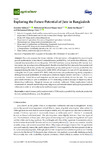Exploring the future potential of jute in Bangladesh
| dc.contributor.author | Rahman, S | |
| dc.contributor.author | Kazal, MMH | |
| dc.contributor.author | Begum, IA | |
| dc.contributor.author | Alam, MJ | |
| dc.date.accessioned | 2017-12-30T13:18:03Z | |
| dc.date.available | 2017-12-30T13:18:03Z | |
| dc.date.issued | 2017-12-01 | |
| dc.identifier.issn | 2077-0472 | |
| dc.identifier.issn | 2077-0472 | |
| dc.identifier.other | ARTN 96 | |
| dc.identifier.uri | http://hdl.handle.net/10026.1/10461 | |
| dc.description.abstract |
© 2017 by the authors. Licensee MDPI, Basel, Switzerland. The study assesses the future potential of the jute sector in Bangladesh by examining its growth performance, international competitiveness, profitability, and production efficiency using national time-series data of over the period 1973-2013 and farm survey data from 289 farmers from two major jute growing areas of Bangladesh. Results revealed that the jute sector has experienced substantial growth in area, production, productivity, prices, and exports. However, productivity has stagnated during the latter 10-year period (2004-2013), while it grew at a rate of 1.3% per annum (p.a.) during the first 31-year period (1973-2003). Only traditional jute production is globally competitive, although financial profitability of white jute is relatively higher (benefit cost ratio = 1.24 and 1.17, respectively). Land, labor, and irrigation are the main productivity drivers for jute. The mean production efficiency of jute is estimated at 75% indicating substantial scope to improve yield by eliminating inefficiency. Marginal farmers are relatively inefficient. Policy implications include investments in research and development, irrigation, and tenurial reform and export protection for white jute in order to revive the sector and boost export earnings. | |
| dc.format.extent | 96-96 | |
| dc.language | en | |
| dc.language.iso | en | |
| dc.publisher | MDPI | |
| dc.subject | competitiveness | |
| dc.subject | policy analysis matrix (PAM) analysis | |
| dc.subject | profitability | |
| dc.subject | stochastic production frontier | |
| dc.subject | technical efficiency | |
| dc.subject | jute | |
| dc.subject | Bangladesh | |
| dc.title | Exploring the future potential of jute in Bangladesh | |
| dc.type | journal-article | |
| dc.type | Article | |
| plymouth.author-url | https://www.webofscience.com/api/gateway?GWVersion=2&SrcApp=PARTNER_APP&SrcAuth=LinksAMR&KeyUT=WOS:000423493500001&DestLinkType=FullRecord&DestApp=ALL_WOS&UsrCustomerID=11bb513d99f797142bcfeffcc58ea008 | |
| plymouth.issue | 12 | |
| plymouth.volume | 7 | |
| plymouth.publication-status | Published | |
| plymouth.journal | Agriculture | |
| dc.identifier.doi | 10.3390/agriculture7120096 | |
| plymouth.organisational-group | /Plymouth | |
| plymouth.organisational-group | /Plymouth/Faculty of Arts, Humanities and Business | |
| plymouth.organisational-group | /Plymouth/Users by role | |
| dcterms.dateAccepted | 2017-11-24 | |
| dc.identifier.eissn | 2077-0472 | |
| dc.rights.embargoperiod | Not known | |
| rioxxterms.versionofrecord | 10.3390/agriculture7120096 | |
| rioxxterms.licenseref.uri | http://www.rioxx.net/licenses/all-rights-reserved | |
| rioxxterms.licenseref.startdate | 2017-12-01 | |
| rioxxterms.type | Journal Article/Review |


